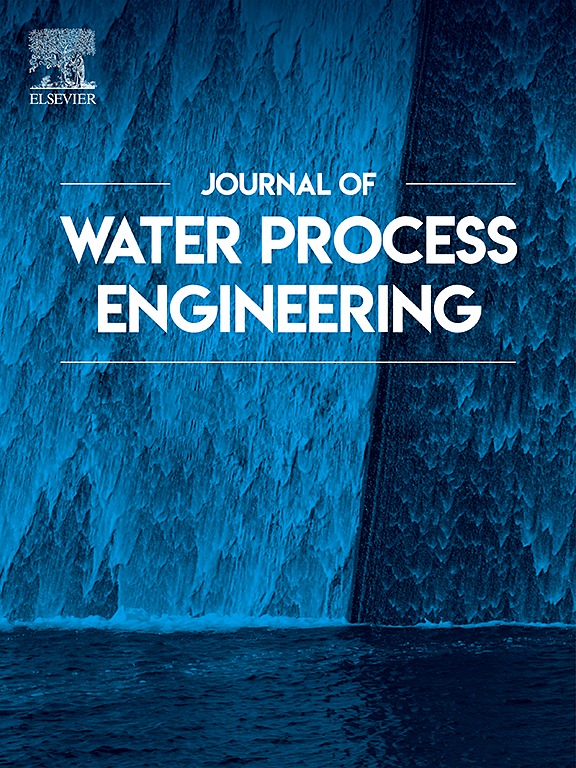Evaluation of full-scale side-stream PN/A process and impact of sulfate ions on anammox in a municipal WWTP in Korea
IF 6.3
2区 工程技术
Q1 ENGINEERING, CHEMICAL
引用次数: 0
Abstract
This study presents the first full-scale implementation and performance assessment of a two-stage partial nitritation/anammox (PN/A) process deployed at a municipal wastewater treatment plant (WWTP) in Korea. The system consists of a sequencing batch reactor (SBR) -based partial nitritation unit and a continuous stirred tank reactor (CSTR) -based anammox unit. Four distinct operational phases were systematically examined over a one-year period: microbial inoculation, sulfate inhibition analysis, process recovery and loading escalation, and final performance validation. Sulfate concentrations exceeding 500 mg/L in the digestate were identified as a critical inhibitory parameter for anammox activity, reducing the specific anammox activity (SAA) by >50 %. By replacing high-sulfate reclaimed water with industrial-grade water, sulfate concentrations were lowered to below 50 mg/L, resulting in consistently stable nitrogen removal performance. Under steady-state conditions, the system achieved a nitrogen removal efficiency of 84.6 % with a nitrogen loading rate (NLR) of 0.89 kgN/m3/day and a hydraulic retention time (HRT) of 1.5 days. Stoichiometric ratios (Rs = 1.33, Rp = 0.13) closely matched theoretical expectations, confirming anammox as the predominant nitrogen removal mechanism. This study underscores that stringent sulfate control is essential for stable PN/A operation in digestate treatment settings and offers a model framework for analogous full-scale applications in high-sulfate industrial wastewater scenarios.
韩国某城市污水处理厂全尺寸侧流PN/A工艺评价及硫酸盐离子对厌氧氨氧化的影响
本研究介绍了在韩国城市污水处理厂(WWTP)部署的两阶段部分硝化/厌氧氨氧化(PN/ a)工艺的首次全面实施和性能评估。该系统由基于顺序间歇反应器(SBR)的部分硝化装置和基于连续搅拌槽反应器(CSTR)的厌氧氨氧化装置组成。在一年的时间里,系统地检查了四个不同的操作阶段:微生物接种,硫酸盐抑制分析,工艺恢复和负荷升级,以及最终的性能验证。消化液中硫酸盐浓度超过500 mg/L被确定为厌氧氨氧化活性的关键抑制参数,使厌氧氨氧化活性(SAA)降低50%。用工业级水替代高硫酸盐再生水,硫酸盐浓度降至50 mg/L以下,脱氮性能持续稳定。在稳态条件下,该系统的脱氮效率为84.6%,氮负荷率(NLR)为0.89 kgN/m3/天,水力停留时间(HRT)为1.5天。化学计量比(Rs = 1.33, Rp = 0.13)与理论预测非常吻合,证实厌氧氨氧化是主要的脱氮机制。该研究强调了严格的硫酸盐控制对于消化处理环境中稳定的PN/A操作至关重要,并为高硫酸盐工业废水场景的类似全面应用提供了模型框架。
本文章由计算机程序翻译,如有差异,请以英文原文为准。
求助全文
约1分钟内获得全文
求助全文
来源期刊

Journal of water process engineering
Biochemistry, Genetics and Molecular Biology-Biotechnology
CiteScore
10.70
自引率
8.60%
发文量
846
审稿时长
24 days
期刊介绍:
The Journal of Water Process Engineering aims to publish refereed, high-quality research papers with significant novelty and impact in all areas of the engineering of water and wastewater processing . Papers on advanced and novel treatment processes and technologies are particularly welcome. The Journal considers papers in areas such as nanotechnology and biotechnology applications in water, novel oxidation and separation processes, membrane processes (except those for desalination) , catalytic processes for the removal of water contaminants, sustainable processes, water reuse and recycling, water use and wastewater minimization, integrated/hybrid technology, process modeling of water treatment and novel treatment processes. Submissions on the subject of adsorbents, including standard measurements of adsorption kinetics and equilibrium will only be considered if there is a genuine case for novelty and contribution, for example highly novel, sustainable adsorbents and their use: papers on activated carbon-type materials derived from natural matter, or surfactant-modified clays and related minerals, would not fulfil this criterion. The Journal particularly welcomes contributions involving environmentally, economically and socially sustainable technology for water treatment, including those which are energy-efficient, with minimal or no chemical consumption, and capable of water recycling and reuse that minimizes the direct disposal of wastewater to the aquatic environment. Papers that describe novel ideas for solving issues related to water quality and availability are also welcome, as are those that show the transfer of techniques from other disciplines. The Journal will consider papers dealing with processes for various water matrices including drinking water (except desalination), domestic, urban and industrial wastewaters, in addition to their residues. It is expected that the journal will be of particular relevance to chemical and process engineers working in the field. The Journal welcomes Full Text papers, Short Communications, State-of-the-Art Reviews and Letters to Editors and Case Studies
 求助内容:
求助内容: 应助结果提醒方式:
应助结果提醒方式:


